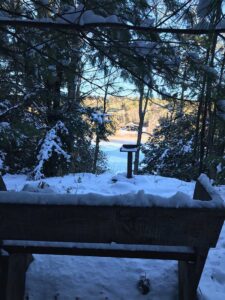Our Environment, Animal Tips & the Great Outdoors

Into the Woods – Why Your Kids Need Nature
An attachment to the natural world is a critical component of childhood development. Spending unstructured time outdoors is therapeutic and restorative. It can boost creativity, ease anxiety and depression, build attention spans, and help develop capacities to self-soothe and be comfortable with solitude. Yet, increasingly children spend more time indoors, more time on screens, more time electronically connected, and up until COVID-19, more time undertaking structured play and organized sports.
 Richard Louv, author of Last Child in the Woods and founder of the Children and Nature Network, coined the term “nature-deficit disorder” to describe “the human costs of alienation from nature.” Among these are diminished use of the senses, attention difficulties, and higher rates of physical and emotional illness. The flip side of this is natural abundance, which are the myriad benefits of a positive relationship with nature.
Richard Louv, author of Last Child in the Woods and founder of the Children and Nature Network, coined the term “nature-deficit disorder” to describe “the human costs of alienation from nature.” Among these are diminished use of the senses, attention difficulties, and higher rates of physical and emotional illness. The flip side of this is natural abundance, which are the myriad benefits of a positive relationship with nature.
Louv cites E.O. Wilson’s term “biophilia” to provide a foundation for why connecting to the natural world is part of being human. Biophilia refers to the “urge to affiliate with other forms of life.” It’s a desire for and feeling of connectedness to the natural world that stems from an evolutionary and deep-seated need to be in a relationship with nature.
Howard Gardner, the founder of the multiple intelligences theory, posits that IQ is a limited measure of intelligence. He asserts that there are at least eight different ways in which intelligence can manifest itself. One of these is naturalistic intelligence. This intelligence involves distinguishing, identifying, and classifying elements and species of the natural world. It relies strongly on paying attention and noticing details, which has applications and value throughout the human-made world.
So how can we help our children reduce nature deficit disorder, cultivate their innate connection to the natural world, and develop a naturalistic intelligence? The answer is creating opportunities for them to be outside, explore, observe, and draw attention to, and talk about the benefits that nature can provide for them.
Great Mountain Forest, straddling Norfolk and Falls Village, CT, with its 6,200 acres of forest and trails, is a place that can call forth Louv’s idea of natural abundance.
 Perfect for families with children (and anyone else), is the Tamarack Interpretive Trail at the Forest’s West Gate in Norfolk. Its natural terrain covers a ¾ mile loop around Tamarack Pond, and begins near the visitor parking area and Forest office.The path passes through a hemlock forest, crosses a stream, provides a lookout over the pond, and meanders along a stone wall. At the end of the trail you can return the way you came or follow a wide trail path to the left that circles around the rest of the pond and back to the forest office and parking area.
Perfect for families with children (and anyone else), is the Tamarack Interpretive Trail at the Forest’s West Gate in Norfolk. Its natural terrain covers a ¾ mile loop around Tamarack Pond, and begins near the visitor parking area and Forest office.The path passes through a hemlock forest, crosses a stream, provides a lookout over the pond, and meanders along a stone wall. At the end of the trail you can return the way you came or follow a wide trail path to the left that circles around the rest of the pond and back to the forest office and parking area.
Bright yellow circular markers allow your tiny trail guide to navigate your adventure. Beside the trail are descriptive signs to educate young naturalists and allow them exercise their reading skills. These plaques describe the natural and human-made sights and structures along the way.
A bench near the pond allows for resting and observing the beauty and sounds of the forest. Sitting and watching bird life on the pond is a perfect time to dwell in silence or spur a conversation about what your child has noticed and how they’re feeling. This moment is a priceless time in a sacred setting: nature. Breathe deeply and be still – a meditative exercise that is a healing emotional natural resource for your child.
The lessons that nature and the forest teach are ones that you’re never too young to learn, and the benefits can last a lifetime.
The Tamarack Trail at Great Mountain Forest’s West Gate is located at 201 Windrow Road, Norfolk, CT. The Tamarack Interpretive Trail was made possible with a grant from the Housatonic Heritage Foundation.
Article By Mary B. O’Neill, Ph.D.

The mission of Great Mountain Forest is to promote the working forest as a renewable resource, as a habitat for wildlife, and as a classroom for training and education. We leave the forest better than we found it, pass on all that we learn to others, and provide a sanctuary for those who love the woods.



